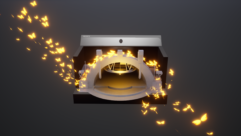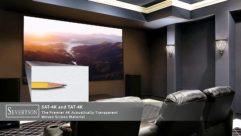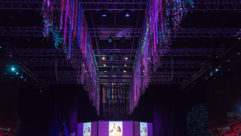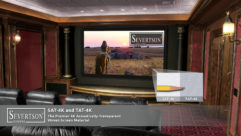
Technology Showcase: Special Effects
Dec 1, 2004 12:00 PM,
By John McJunkin
The current crop of digital effects processors brings an array of complex programming and advanced feature combinations.
One item in the rack that’s every bit as important as any amp, EQ, or compressor is an effects processor. In the good/bad old days, a single, simple reverb would likely do the trick for most fixed installation applications. But audiences have become more sophisticated and so has the music. Now it’s not uncommon for a performing arts center or house of worship to have a rack full of reverbs, delays, and more.
Alesis PicoVerb
More boxes equal more rack space, so many manufacturers have developed multi-purpose units that are capable of a lot more than just reverb or delay. For instance, there are complex programs on some boxes that encompass reverb, delay, chorusing, and EQ, all in one fell swoop. Sometimes the boxes are under the control of a MIDI sequence, allowing for even more sophistication.
We’re going to take a look at a large number of effects processors, and in order to fit this examination into the space at our disposal, I’m going to limit the selections to digital multi-effects boxes with memory presets. There are legendary reverbs, like the Lexicon 480L, that are no longer available yet remain tremendously popular. An attempt to include all such products would require a huge amount of space, so I’m going to limit this to only products that are currently available — and while we have exhaustively sought as many as possible, we don’t claim to list every device available. I’ll work through the list in alphabetical order by manufacturer name. Let’s get started!
Alesis starts us off with four products: MIDIVerb 4, MicroVerb 4, NanoVerb, and PicoVerb.
The MIDIVerb 4 sports two banks of 128 programs each, one with factory presets and the other with user presets. Its A/D and D/A converters sport 18-bit resolution, and internal processing resolution is 24 bit. There are six different fundamental reverb algorithms, which can be tweaked to your liking, and delay and pitch effects, along with an auto-panning function. Effects can be used individually or together in a multiple effect configuration.
The MicroVerb 4 is a similar unit with slightly fewer bells and whistles. It offers 100 factory presets and 100 user-programmable presets based on five fundamental reverb algorithms, delays, pitch shifting, and auto-panning. As with the MIDIVerb 4, there are both individual and multi-effect presets, and A/D/A conversion happens at 18-bit resolution with 24-bit internal processing.
The NanoVerb is a half-rack sized unit with 16 factory presets based on five basic reverb algorithms. A mono delay is also available, as are chorusing, flanging, and a “rotary” program approximating a Leslie speaker. Like Alesis’ other products, A/D/A conversion is at 18-bit resolution with 24-bit internal processing. A clever scheme allows a tiny bit of tweaking via the unit’s front panel “adjust” knob.
Finally, Alesis offers the PicoVerb. As implied by the name, this is a tiny unit that features 16 presets, including eight reverbs, two delays, two chorus/room combinations, dry chorusing, flanging, vocal elimination, and a “rotary” effect.
Applied Research and Technology checks in with just a single unit, the FX-1. This is a sandwich-sized desktop unit with two banks of 15 presets each, including reverbs, delays, chorusing, phase shifting, pitch shifting, tremolo, and panning. Effects can be used individually, or in multi-effect configurations of up to three effects simultaneously. Also, since there are two inputs and two outputs, dual channel effects are available.

Behringer Virtualizer
Behringer adds two processors to the collection, the V-Verb Pro REV2496 and the Virtualizer Pro DSP2024P. The V-Verb features 24-bit/96kHz A/D/A conversion, and four-channel operation, effectively yielding two stereo processors. The internal SHARC processing is executed at 32-bit resolution. AES/EBU and S/PDIF digital I/O are also featured, including a word clock input for synchronization with other digital gear. Separate ROM and user-programmable presets store 400 programs based on eight modeled reverb algorithms. Delays, chorusing, flanging, and compression are also available.
The Virtualizer features 24-bit conversion of its two inputs and outputs. This unit is primarily intended to provide natural reverbs and delays via its wave-adaptive virtual room algorithms, but modulation, dynamics, psychoacoustic, and EQ programs are also available for a total of 71 algorithms. Amp simulation, distortion, and other special effects are also featured. There are 11 effects combinations with selectable serial/parallel configurations.
Digitech offers these three processors: the Quad4, the S100, and the S200. The Quad4 sports four independent 1/4in. analog inputs and outputs for true stereo operation. There are 16 effect configurations, with up to four effects at one time. The unit operates at 24-bit, 44.1kHz resolution, and offers 100 factory and 100 user presets. Among the unit’s algorithms are reverbs, choruses, flangers, auto-panners, auto wah, tremolo, a vocoder, a vocal eliminator, intelligent pitch shifting, delays, rotary speaker simulation, compression, and a noise gate.
The S100 operates at 24 bits at a sample rate of 46.875kHz, with two analog inputs and two analog outputs, all of the 1/4in. variety. There is also a MIDI input to affect program changes. There are 99 factory and 99 user presets, including chorusing, flanging, phasing, tremolo, auto-panning, rotary speaker simulation, pitch shifting, detuning, delays, ring modulation, compression, a vocoder, and an array of reverbs.
The S200 is a bit more sophisticated than the S100, being a dual-engine processor. It operates at 24-bit, 46.875kHz resolution, and features stereo analog 1/4in. I/O. The MIDI input allows for program changes, program dump, and MIDI continuous controllers. The unit’s two engines are configurable in a number of serial or parallel routings. Among its effects algorithms are chorusing, flanging, phasing, tremolo, auto-panning, rotary speaker simulation, pitch shifting, detuning, delays, ring modulation, compression, a vocoder, a de-esser, and a healthy selection of reverbs.

Eventide Orville
Eventide provides five entries: the H8000, the Eclipse, the Orville, the DSP7000, and the DSP4000B+.
The H8000 is a powerhouse with eight AES/EBU, S/PDIF, and ADAT digital inputs and outputs. Two channels of analog I/O are also featured. There are two internal DSP engines that can be operated in parallel or series, or in other configurations. More than a thousand factory programs are included, with memory for hundreds of user-programmed presets, along with the ability to store presets on memory cards or via computer connections. Reverbs, chorusing, flanging, pitch shifting, dynamics, EQs, filters, distortion, ring modulation, and synthesis are among the capabilities of this unit. Lengthy sampling and delay times are also available.
The Eclipse is another dual-engine processor with AES/EBU, S/PDIF, optical, ADAT, and analog I/O. It’s a 24-bit system with time resolution of up to 96kHz. In addition to the traditional reverb, delay, and pitch shifting presets, this unit also affords envelope followers and ADSR envelope generators with tempo-synch-able LFOs to provide control signals. Delay times can also be controlled by tempo. The two engines can be used in serial, parallel, or dual-mono modes.
The Orville is similar in many respects to the H8000, with the notable exception of I/O. In terms of digital I/O, you can have either four AES/EBU or two AES/EBU, and two S/PDIF I/O pairs. There are four pairs of analog I/O. This is also a dual-engine processor, with reverbs, delays, flanging, chorusing, pitch shifting, dynamics, EQs, filters, ring modulation, distortion, sampling, and synthesis. System tempo can be used to synchronize LFOs and delays too.
The DSP7000 is a stereo, single-engine version of the Orville, with similar processing capabilities. The major distinction is that the DSP7000 has two channels of digital I/O (AES/EBU and S/PDIF) and two channels of analog I/O. For all practical purposes, the DSP4000B+ is the same as the DSP7000. Both of these units, like other Eventide products, have PCMCIA preset storage along with computer connectivity.
Kurzweil gives us the KSP8. This processor provides four pairs of balanced/unbalanced analog I/Os and an AES/EBU I/O. There is also optional I/O yielding up to 14 I/O pairs in TDIF, ADAT, and Kurzweil’s proprietary KDS formats. The fundamental algorithms in the unit are reverb, delay, chorus, flange, phaser, tremolo, rotary, spatial, distortion, dynamics, filters, oscillators, and “combinations.” Mono, stereo, and 5.1 surround processing are available with the KSP8. Presets can be stored internally or on SmartMedia memory cards. Extensive internal signal routing options allow sophisticated preset programming.
Lexicon checks in with six processors for us to examine: the 960L, the PCM81, the PCM91, the MPX110, the MPX550, and the MPX1.
The 960L is a world-class reverb processor with support for two DSP cards (one is included) that feature up to four stereo engines or two surround engines at a 48kHz sample rate. The unit is 96kHz capable, although at that resolution only two stereo or one surround engine is available. Two I/O configurations are available: eight channels of balanced analog I/O and four AES/EBU pairs, or just four AES/EBU pairs. A word clock input allows for synch with other digital devices, and it ships with a LARC2 control surface. There are 240 factory programs and 1,000 user presets available in the 960L. This is a dedicated reverb device with no delays, modulation, dynamics, or EQ processing available, but extensive parametric control makes this one of the deepest and most sophisticated reverbs in the world.
The PCM81 is a multi-effects device with stereo analog I/O and AES/EBU digital I/O. There are 300 presets based on reverb, delays, pitch shifting, EQ, and other special effects. It can receive MIDI tempo or export its own internal tempo to other devices via MIDI. A PCMCIA SRAM slot allows for storage of up to 2,350 presets on a 1MB card.
The PCM91 is a reverb-only device with 450 presets. Stereo analog I/O and AES/EBU digital I/O are both available. A unique patching and modulation system provides two LFOs, an AR envelope generator, an envelope follower, latch and time switches, MIDI delay, and sample and hold. These are intended to create modulation sweeps. MIDI tempo can be received from external devices or tapped in and exported via MIDI.
The MPX110 is a dual-channel processor that operates at 24-bit resolution. Reverbs, tremolo, rotary, chorus, flange, pitch shifting, detuning, delay, echo and “inverse” are among the 240 presets available. As with other Lexicon devices, tempo can be accepted via MIDI input or tapped in, with the option of exporting internal tempo via MIDI. Via internal signal routing, two independent effects can be used at once.
The MPX550 is also a dual-channel processor, with the ability to process in parallel, cascade, mono split, and dual mono configurations. There are 255 factory presets and memory for 64 user presets. In addition to the traditional reverb, delay, chorus, flange, and pitch shifting algorithms, this unit is capable of dynamics processing for mastering purposes. A/D/A conversion and internal processing tasks are handled at 24-bit resolution.
Finally, Lexicon gives us the MPX1, which has six primary effects: reverb, delay, modulation, chorus, EQ, and pitch. As many as four stereo effects can be used simultaneously, with reverb in operation as well. Stereo analog balanced/unbalanced I/O is featured, along with S/PDIF digital I/O.

Nady DSP-256
Nady gives us the SDP-20 and DSP-256. The SDP-20 features 256 presets, including reverbs, gates, delays, chorusing, flanging, Leslie simulation, pitch shifting, and distortion. There are also 20 memory locations in which to store user-edited presets. A/D/A conversion and internal processing happen at 20-bit resolution. There is also a four-band digital equalizer. Separate balanced and unbalanced analog I/Os are available, and the unit can send and receive MIDI, enabling parametric control of the unit via SysEx.
The DSP-256 is a third-rack space processor with 16 effects programs, including reverbs, chorus, flanging, delays, tremolo, combined chorus/reverb, and rotary speaker simulation. Each program has 16 parameter adjustments available, yielding 256 different variations. Stereo unbalanced analog I/O gets signal in and out of the unit, and a separate input allows the unit to be bypassed with a footswitch. A/D/A conversion is 18 bit, and internal processing happens at 56-bit resolution.

Peavey Deltafex
Peavey contributes the Deltafex. Sixteen presets encompass chamber, plate, room, “cathedral,” and spring reverbs. Additionally, there are gate, reverse, delay/reverb, delay, chorus, phaser, flanging, and rotary speaker simulation effects. There are two adjustable parameters for each program, and the unit features a footswitch input. For reverb presets, the footswitch toggles the inputs on and off, allowing reverb tails to decay naturally. When using a rotary speaker simulation, the footswitch controls rotation speed. Stereo analog I/Os are featured, and A/D/A conversion is at 16-bit resolution.
TC Electronic adds six processors to our examination: the System 6000, the Reverb 4000, the M3000, the M2000, the M-One XL, and the M300.
The System 6000 is a superior processor, among the world’s finest. It ships with the ICON remote control, and also features computer control. There are 50 factory and 50 user “scene” presets, 50 factory and 50 user “routing” presets, and 13 banks with 100 factory presets each for the four engines in the system, along with 100 such user presets. As many as 32 channels of I/O can be addressed by the System 6000 in the AES/EBU format, and sophisticated internal routing allows for complex effects. Word clock and SMPTE inputs yield synchronization with other devices, and MIDI connections allow realtime control from a sequencer and other types of communication. An Ethernet/LAN connection is included, along with two USB connectors and PC keyboard/mouse and VGA monitor connections. The maximum resolution of the system is 24-bit/96kHz.
System 6000 is best known for reverb, but dynamics processing is also a feature, along with EQ, pitch shifting, traditional modulation and delay effects, noise reduction, and the 5.1 surround “toolbox” programs. The Reverb 4000 is the single-engine version of the System 6000, a reverb-only system capable of processing two discrete inputs separately or processing a composite stereo source. A/D/A conversion is at 24 bits of resolution and 44.1kHz to 96kHz sample rates are supported. Stereo balanced analog I/O is featured, along with ADAT or S/PDIF optical, AES/EBU, and RCA S/PDIF I/O. A word clock input enables synch with other digital devices, and it can be operated as a standalone or with the ICON remote. There are 150 factory presets, cleverly arranged by likely uses.
The M3000 contains 500 “single” factory presets, 100 “combined” factory presets, 250 user-generated “single” presets, and 50 user-generated “combined” presets, for a total of 900, including reverbs, delays, detuning, dynamics, EQ, modulation, and tremolo. A PCMCIA card slot allows for unlimited storage. The unit features stereo balanced analog I/O, ADAT and TOS-Link optical, AES/EBU, and S/PDIF I/O. It’s a two-engine processor with A/D/A conversion at 24-bit resolution.
The M2000 is another two-engine system with stereo balanced analog I/O, and AES/EBU and S/PDIF digital I/O as well. There are 128 “normal” factory presets, 128 “normal” user presets, 128 “combined” factory presets, and 128 “combined” user presets, for a total of 512. Reverb, delay, chorus, flange, pitch-shift, EQ, tremolo, spatial, and dynamics programs are available. A/D/A conversion is 24-bit resolution.
The M-One XL is yet another two-engine system with reverbs, delays, chorusing, flanging, pitch shifting, EQ, dynamics, tremolo, and phasing. There are stereo balanced analog I/Os and S/PDIF digital I/O. Flexible signal routing enhances the usefulness of this unit, and A/D/A conversion happens at 24-bit resolution.
Finally, the M300 is also a two-engine system, one devoted to reverb, and the other to delay, chorus, flanging, phasing, tremolo, and dynamics processing. Its front panel is intended for maximum simplicity, and I/O includes stereo balanced analog and S/PDIF digital. A/D/A conversion is 24 bit.
Yamaha offers its SPX2000, SREV1, REV500, REV100, and ProR3 processors.
First, let’s look at the SPX2000, the latest unit with the legendary SPX pedigree. This is a 24-bit/96kHz system with 122 programs that can be edited by the user. Computer connectivity is supported (via USB), enabling editing and storage of programs. Stereo balanced analog I/O is featured, along with AES/EBU digital I/O. A word clock input allows synchronization with other devices. The programs include reverb, delay, modulation, tremolo, panning, ring modulation, filtering, and pitch shifting. Effects can be used individually or together.
The SREV1 is a sophisticated convolution reverb device that “samples” acoustical spaces and reproduces their characteristics. Stereo reverb is available, along with a four-channel (quad) mode. Up to six programs can be stored in four-channel or two-channel × 2 modes and 12 in two-channel mode. An included CD-ROM features the reverb characteristics of famous venues worldwide. Parametric EQ is also controllable by the user. Two AES/EBU digital I/Os are featured, along with two of Yamaha’s proprietary YGDAI slots, yielding a number of I/O options, including AES/EBU, ADAT, and T-DIF. I/O conversion is at 24-bit resolution, and internal processing is at 32 bits. The 44.1kHz and 48kHz sample rates are supported. An optional RC-SREV1 remote controller is also available.
The REV500 is a 20-bit/44.1kHz reverb unit with 100 factory preset programs and 100 user programs. It features stereo balanced analog I/O, and MIDI connectivity. There are four program types: hall, room, plate, and special, with gating available. Delays, flanging, chorusing, panning, and tremolo are also available.
The REV100 is a 16-bit/44.1kHz reverb/delay/modulation system. It’s a true stereo unit with analog I/O and a MIDI connection for program selection and modification. There are 99 factory programs with limited user modification available. Room, plate, hall, and chamber type reverbs are available, in addition to the various delay and modulation type effects.
The ProR3 offers reverbs along with various delay and modulation effects, not unlike the REV100. This is a more sophisticated unit, with 20-bit I/O conversion and 32-bit internal processing. The I/O is strictly analog, balanced and unbalanced. Hall, room, chamber, and plate type reverbs can be used individually or together with gates, delays, flanging, and filtering. MIDI in, out, and thru connections allow for selection and control of programs, not to mention SysEx bulk data dumping and retrieval.
Zoom contributes two boxes to our collection, the RFX-1100 and the RFX-2200. Both process audio at 44.1kHz, 24-bit resolution, with 121 reverb presets, a front-panel XLR jack, mic and cabinet simulation algorithms, and lo-fi, resonance, and ring modulation effects. The RFX-1100 has 33 types of multi-effects, while the RFX-2200 has 48. The 2200 is also more sophisticated by virtue of 100 user presets, an S/PDIF output, a MIDI input for program change or parameter control, and tap tempo function. Both are single rack-space units.
From this list, you can tell there are a lot of choices available. The range of quality and prices is vast, and these are two parameters that will certainly weigh heavily into a buyer’s decision.
If you’re in the market, listen to as many units as you can, and bear in mind the ultimate applications for your unit. High-end reverb boxes are great, and provide the most flexibility, but you may be able to get by with something less expensive if your application isn’t that critical. Moreover, the “ear” of your audience may be accustomed to, and even desirous of, grittier, grainier effects that won’t break the bank.
Think about your applications, examine your budget, then listen, listen, listen! With such a broad array of choices, I can virtually guarantee you’ll find an effects box that fits the bill for your needs.
John McJunkinis the principal of Avalon Audio Services in Phoenix and engages in consulting for both studios and live sound applications.
For More Information
Alesis
www.alesis.com
Applied Research and Technology
www.artroch.com
Behringer
www.behringer.com
Digitech
www.digitech.com
Eventide
www.eventide.com
Kurzweil
www.kurzweilmusicsystems.com
Lexicon
www.lexiconpro.com
Peavey
www.peavey.com
TC Electronic
www.tcelectronic.com
Yamaha
www.yamaha.com/proaudio










